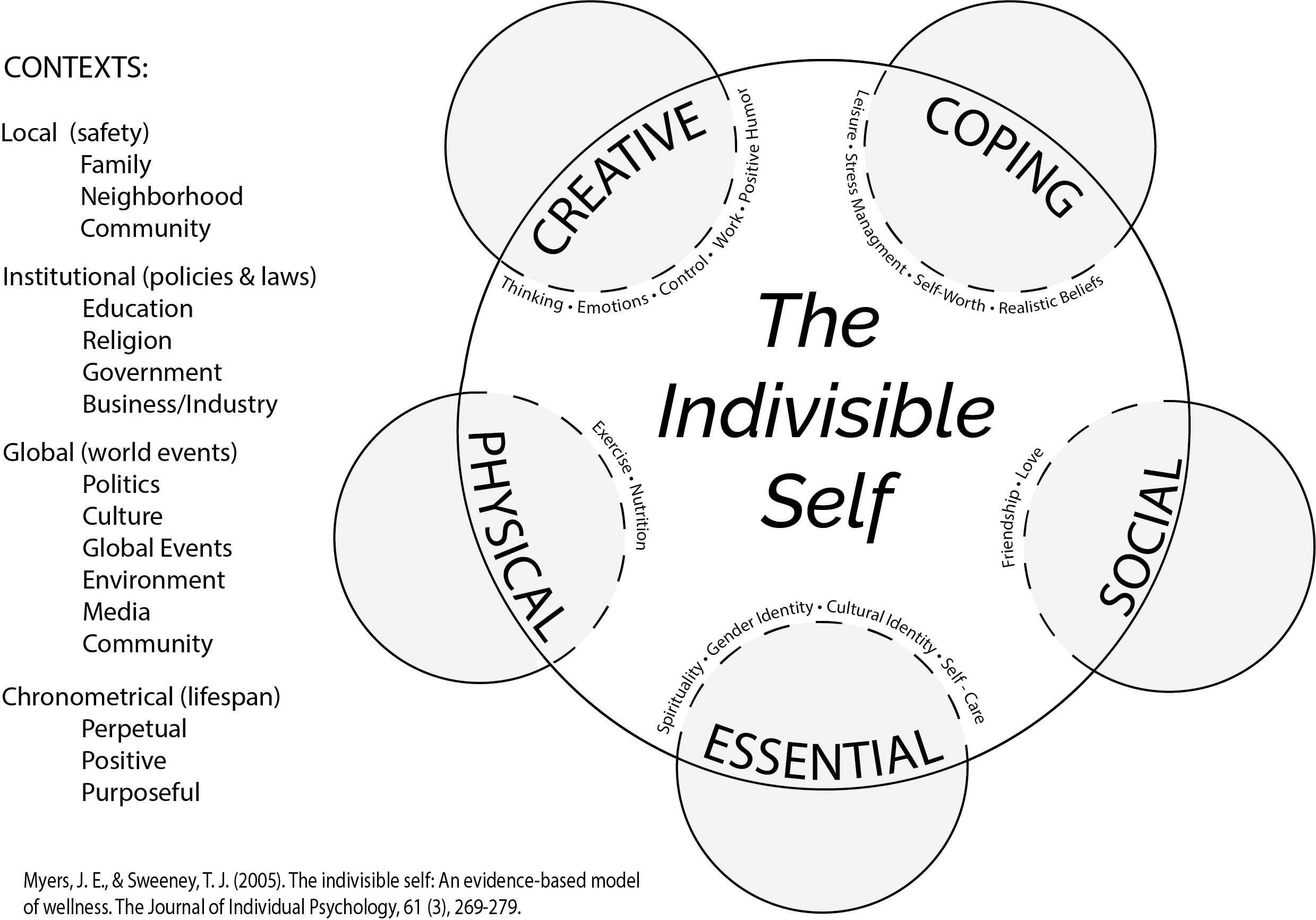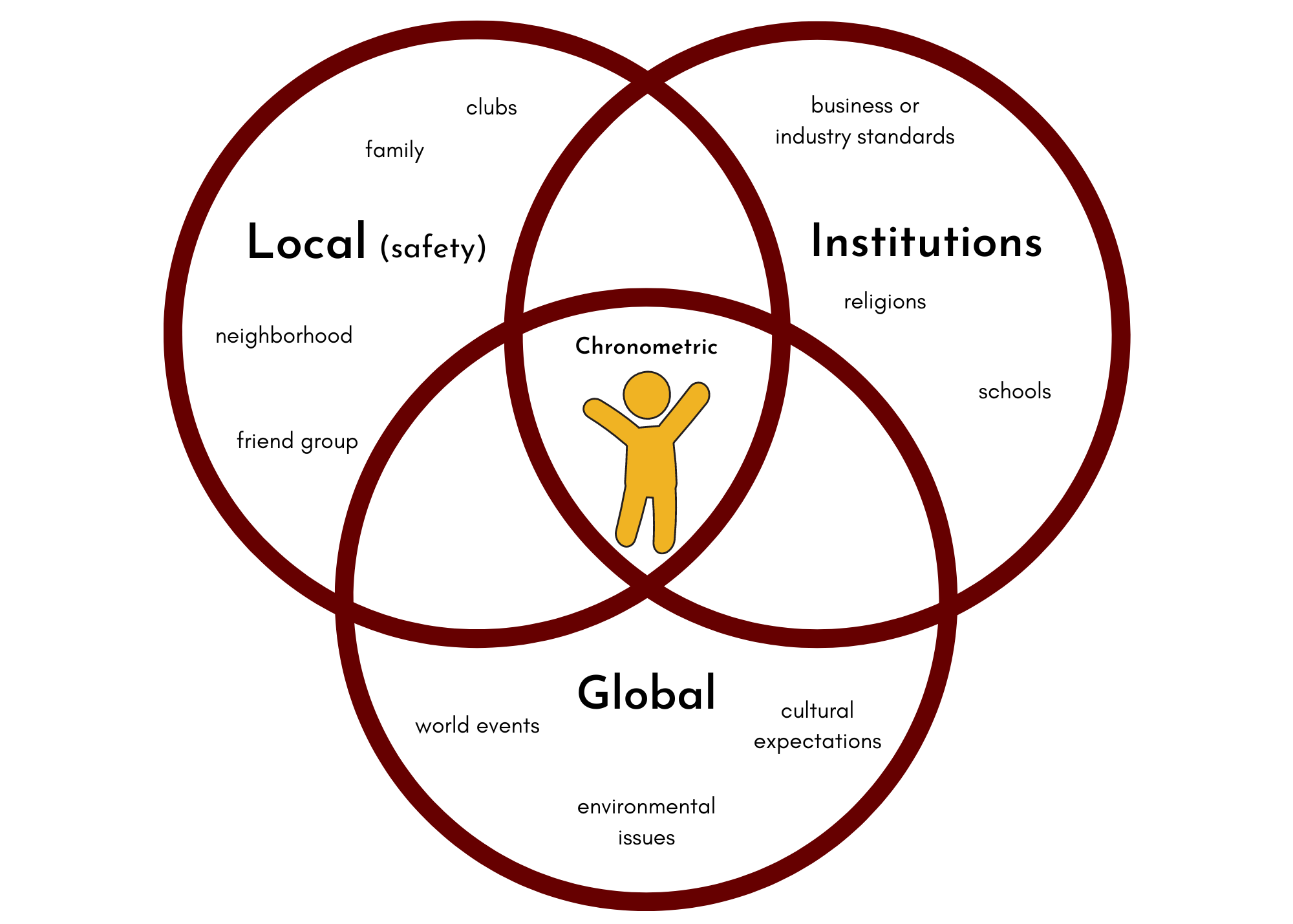The IS-WEL model has its origins in the 1990s, when a group of counselors recognized the shortcomings of other wellness models (focusing solely on physical wellness) and created the Wheel of Wellness, which was assessed by the Wellness Evaluation of Lifestyle (WEL). It was revised in the early 2000s after its creators (Hattie, Myers, and Sweeney) analyzed the data of over 5000 adults who had taken the assessment, using this data to guide their modeling.
Interesting things emerged when they studied the data – not only was some of the data related to each other in ways they didn’t expect, but they were surprised by the strength of the relationship between each individual question and the total wellness score. The researchers recognized in the data this fact: wellness is made up of the whole of our lives, not just one single factor or area - each aspect of who we are is related to our overall wellness. Yet the data also showed clear relationships between some of the areas questioned, sub-segments of wellness, which were all necessary to fully understand the data - removing any of the areas of self below (and looking only at those left) weakened the model’s correlation to overall wellness.
In short: every aspect of our lives has an impact on our wellness, and we can better understand and work towards wellness when we consider all of them.
The Indivisible Self Model of wellness emerged and shows the relationships between an overall “higher-order” wellness factor (The Indivisible Self/Student), five second-order factors (Creative Self, Coping Self, Social Self, Essential Self, and Physical Self) and the 17 subfactors. The second-order factors, all named after Adlerian concepts (fitting, since Adler himself proposed an indivisible self in the mid-twentieth century) are described below.
(It’s important to note here that each subfactor is only included in a single second-order factor from a statistical standpoint. However, that doesn’t mean that subfactor - for example, positive humour or thinking - doesn’t show up in more than one aspect of our selves.)

The IS-WEL model is further unique in how it recognizes (and encourages us to recognize) the ways in which the environment we live in affects our wellness. We don’t exist in a vacuum – we live in cities, go to schools, have families, etc. So it’s good for us to recognize when and where different aspects of our wellness and whole self may be impacted.
Click the contexts below to better understand what is meant by them and read some examples.
These are the people and places we interact with most often and often have the most impact on whether or not we feel safe. This contextual factor looks at the ways we both influence and are influenced by these systems.
Our local contexts might be location-dependent and include things like the neighborhood we live in, our families and friends, and other communities we may belong to like clubs. Some of these may be more or less salient and accessible depending on our physical location – for example, going home on winter break can significantly shift the people and places we interact with.
These contexts generally are more organizational in nature and have a broader reach, but we still feel their impact. Institutions like religion, schools, governments, industry, and media are not necessarily interacting directly with us, but any changes to the overall system will impact us in some way. These may be less location-specific – for example, Winthrop’s decision about tuition will impact us regardless of our location at the time of the decision; government policies or laws may transcend county or even state lines.
We’re not likely to interact directly with these context, but we’re usually able to relate and interact with them in ways that creates personal relevance. Media and the internet have made our world increasingly global in nature, so it makes sense that we feel impacted by wars across the world or racial tension across the state or country. Media is also where we get many of the cultural messages that might influence our beliefs on various aspects of self.
This context is one that acknowledges that we grow and change over time. What we need to be well our freshman year of high school may be entirely different than what we need to be well our freshman year at Winthrop and different again by the time we’re approaching graduation. It also recognizes that impacts on our wellness may be acute or chronic or both – decisions we make about wellness today may impact us today or we may not see the impact until we’re a bit older.
The image below looks at the ways the various contexts may impact us and what we need for our health and wellness – some contexts may be salient all the time and in all locations and others may be less salient while here or at home. Are there aspects of self that are safer when here at Winthrop or when at home? Does the availability of services or support change based on what county or state you’re currently in? Are you more accepted in certain institutional settings vs others?
The most important thing is to be aware of how various contexts might impact us and our indivisible selves so that we can do our best to adjust our ways of coping so as to best maintain overall wellness.

Recognizing ourselves as indivisible and our wellness as being made up of all parts of our selves can help us better understanding the ways that we can move towards holistic wellness. We are finite beings with finite resources, so an increased load in one area of our selves necessarily results in a shift of energies from other areas. For example, if you come down with the flu, this most immediately impacts your physical self, but consider the ways in which it impacts other areas as well: you may miss class or work (creative self), you spend less time with friends while you recuperate (social self), you feel less positive overall due to being sick (coping self). Being overly stressed in one area means that we have less energy and resources to put towards other areas.
However, the reverse is also true: making small changes to improve one aspect of our indivisible selves can have benefits throughout the various factors. For example, meditation (coping) has been shown to reduce negative thinking and depression as well as increase attention span (creative self), improve sleep and reduce pain (physical), and help you increase your compassion toward yourself and others (social, essential). The best part is that research has shown that the amount of meditation needed to gain benefit isn’t that substantial: as little as 13 minutes a day! (Check out our online App Library for free meditation apps or go to headspace.com/studentplan for a reduced subscription price on the popular Headspace app.)
Knowing that small changes can make a difference, what small change might you be able to make over the next few weeks or months to benefit your overall wellness?